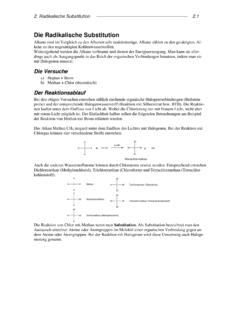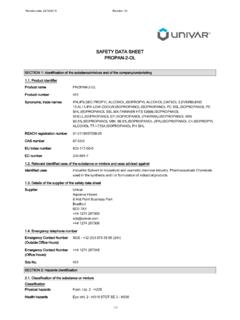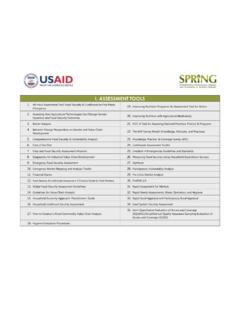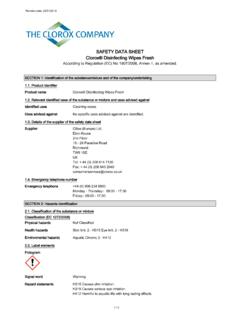Transcription of COVID-19: Guidance for preventing transmission of COVID-19 ...
1 02 August 2021. COVID-19 : Guidance for preventing transmission of COVID-19 . within food businesses Updated Guidance SUMMARY. Current data indicates that neither food nor food packaging is a pathway for the spread of viruses causing respiratory illnesses, including SARS-CoV-2. In other words, SARS-CoV-2 is not a direct food safety concern. However, it is important for the food industry and authorities regulating the food industry to protect all workers from person-to-person spread of these viruses by providing a safe work environment, promoting personal hygiene measures and providing training on food hygiene principles.
2 These measures should be risk-based and proportionate to the level of expected food business worker exposure to SARS-CoV-2: In communities where SARS-CoV-2 is not actively circulating, practices consistent with effective food safety management systems may be sufficient. In contrast, as the prevalence of COVID-19 . increases in the community, the prevention measures adopted should also increase. The purpose of these guidelines is to highlight measures needed to control COVID-19 in food operations, so that the safety of workers is protected, and the safety of the food supply is preserved.
3 These measures should not compromise traditional food safety controls and food safety management, but should complement ongoing food safety practices. Whilst COVID-19 is a global pandemic, the occurrence of the virus may vary greatly within and between countries. Thus, this Guidance should be read in conjunction with the guidelines and advice from national and local public health authorities. Updated with new evidence, this Food and Agriculture Organization of the United Nations (FAO) Guidance replaces the FAO/WHO interim Guidance , COVID-19 and food safety: Guidance for food businesses: Interim Guidance (dated 7 April 2020).
4 BACKGROUND. The world is facing an unprecedented threat from the COVID-19 pandemic caused by SARS-CoV- 2. First and foremost, COVID-19 is a risk for public health generally, as well as an occupational safety risk for workers in any type of business or industry where individuals work in close proximity to one another. However, SARS-CoV-2 itself is not viewed as a direct food safety hazard. Many countries are following the advice from the World Health Organization (WHO). regarding the introduction of physical distancing measures as one of the ways in which transmission of the disease can be reduced (WHO, 2020a).
5 The requirement of physical distancing has caused the closure of many businesses and schools and resulted in restrictions on travel and social gatherings. For some people, working from home, teleworking, and online Guidance for preventing transmission of COVID-19 . within food businesses or through internet discussions and meetings are now more common practice than before the pandemic. However, many food industry employees do not have the opportunity to work from home and are required to continue to work in their usual workplaces. Multiple outbreaks of COVID-19 have indeed occurred among workers on farms and in food processing facilities, likely due to aspects of their work environments that make it challenging for them to keep to strict physical distancing.
6 For the purpose of this Guidance , food workers include all people working in the food business who touch food or food contact surfaces. This includes explicitly also all people who are physically present in the vicinity where food is processed, packaged, or handled. The term can therefore apply as well to managers, cleaners, maintenance contractors, delivery workers, food inspectors and others. Ensuring the safety and well-being of all food workers is of paramount importance. A healthy and sufficient workforce is critical to maintain supply chains operational.
7 In addition to this document, food businesses also need to keep up-to-date with food regulations and any additional advice from competent authorities on other measures that must be implemented as a result of the pandemic. These efforts are essential to maintain trust and consumer confidence in the safety and availability of food. UNLIKELY transmission OF COVID-19 THROUGH FOOD. It is highly unlikely that people can contract COVID-19 from food or food packaging (Goldman, 2020; ICMSF, 2020; NZFSSRC, 2020). Evidence to date does not indicate that food or food packaging is an important pathway for the spread of human respiratory illnesses, including SARS-CoV-2.
8 COVID-19 is primarily transmitted during close contact among people through respiratory droplets and aerosols generated by activities such as coughing, sneezing, shouting, singing and speaking (WHO, 2020a). Alternatively, some respiratory droplets may land on surfaces surrounding the infected person. Coronaviruses cannot multiply in food or on inanimate surfaces; they can only multiply in humans and certain animals. Once in the environment, viruses degrade and becomes less infectious. Several research reports have described the persistence of the SARS-CoV-2 on different surfaces, for instance documenting that the virus can remain viable for up to 72 hours on plastic and stainless steel, up to four hours on copper, and up to 24 hours on cardboard (van Doremalen, Bushmaker et al.)
9 , 2020). Other studies have investigated the stability of the virus on surfaces kept at different temperatures or varying other parameters (Kumar, Singh et al., 2021). While all these investigations add to our understanding of the persistence and survivability of the virus, they have typically been conducted under laboratory conditions, with controlled relative humidity, temperature and other factors, and should therefore be interpreted with caution when considering virus stability under actual conditions of the often cool (or freezing).
10 And humid food processing and transportation environment. It is important to note that, although the detection of virus or viral ribonucleic acid (RNA) remnants on foods and food packaging provides evidence of previous contamination and is not disputed, there is no confirmation of SARS-CoV-2, or any other respiratory illness-causing virus, being transmitted by food or food packaging and causing illnesses in people who touch the contaminated food products or packaging. The virus responsible for COVID-19 is susceptible to most commonly used disinfectants and sanitizing agents used in the food processing environment.













